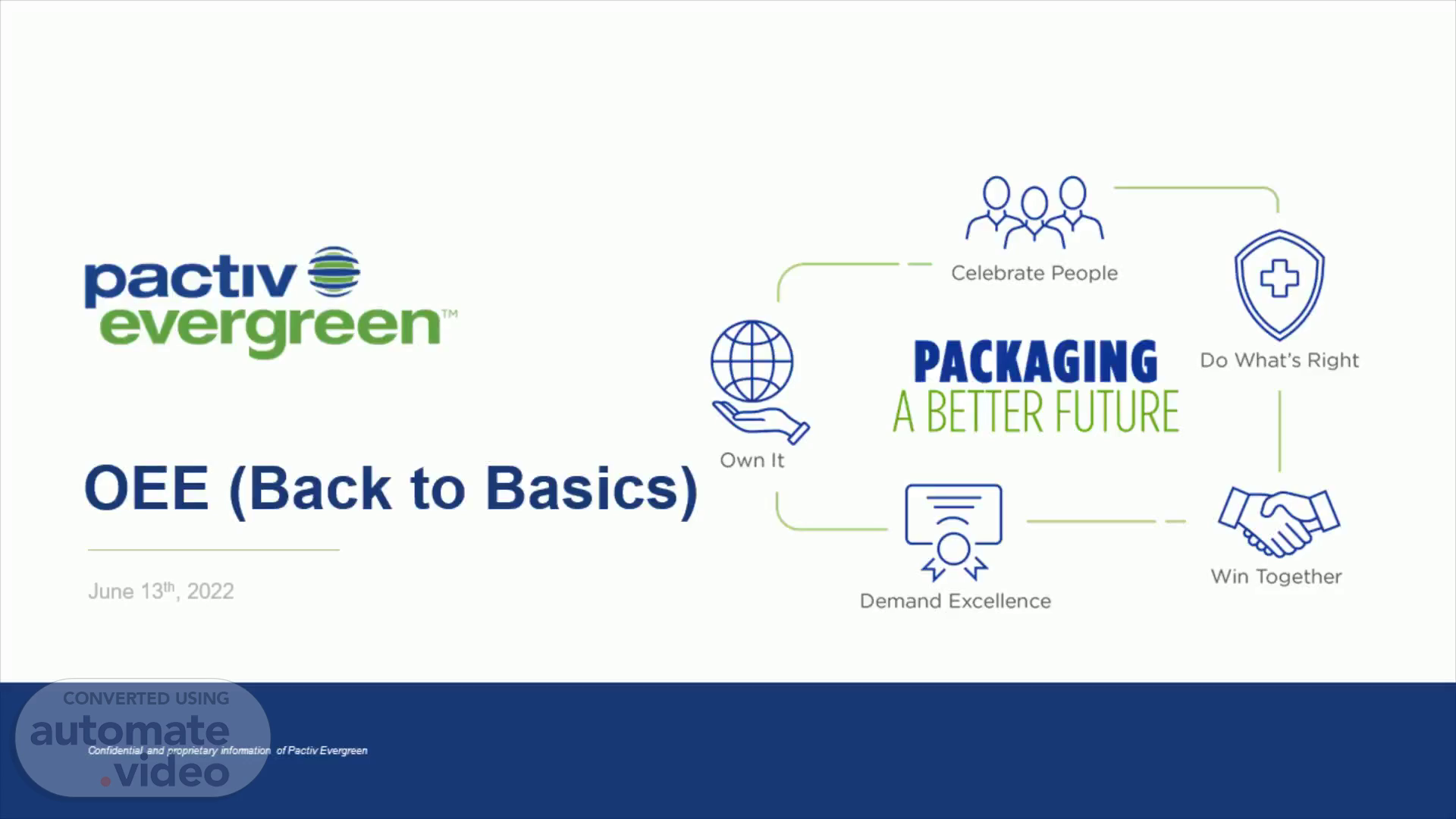
OEE (Back to Basics)
Scene 1 (0s)
[Audio] OEE and also called Overall Equipment Effectiveness - ( Back to Basics) Presentation 5.03 Playbook..
Scene 2 (9s)
[Audio] OEE stands for Overall Equipment Effectiveness and is used as Key Performance Indicator (KPI) to measure machine effectiveness and efficiency. The three key objectives of this module is: 1. To have a standardized methodology for measuring Overall Equipment Effectiveness across all three business units. 2. Capture True OEE one, along with the current OEE two, KPI measurement. 3. Entering Speed Loss and standardize reporting of Chargeable vs Non-Chargeable hours. In the following slides, we will discuss the current state OEE measurement, called historically at Pactiv as OEE two and Future state OEE calculation, referred as "True OEE one". OEE two will continue to be measured as a KPI along with an additional measurement of " True OEE one".
Scene 3 (1m 9s)
[Audio] Current State – OEE Calculations: Currently at Pactiv Legacy, OEE two is measured as Earned Hours divided by Schedule hours using SAP. In other words, referred as Total hours worth product made at engineering machine rate compared to the Total Schedule time for a machine. Although, Fabri-kal doesn't use OEE as a matrix but has a similar way of calculating machine efficiency; which is actual pieces produced divided by standard Pieces for a schedule period of time. Currently Beverage Merchandizing does not measure OEE. Mexico Facilities use OEE but instead of SAP, they use JDE..
Scene 4 (1m 56s)
[Audio] Future State – True OEE Pactiv Legacy OEE two calculation has two main difference compared to True OEE. In Current calculation of OEE two, schedule time for a machine is taken in consideration to measure " availability component" of OEE instead of the Total Operating Capacity Time. Also, there is not enough information to analyze the different loss categories – For example speed Loss and Quality Loss. True OEE is calculated as the product of three separate components. "" Availability x Productivity x Scrap = True OEE"" Where; Availability is measured as Running Time divided by Total Operating Capacity Time. Productivity is measured as Actual Performance Output divided by Target Performance Output And Scrap as Actual Quality output divided by Target Quality Output..
Scene 5 (2m 58s)
[Audio] Here is the detailed calculation for each of the components and how the True OEE is calculated. (A). Total Operating Capacity Time : Total capacity hours ( 24 hours) for a machine. ( B). Running Time: Total Machine hours after unscheduled and downtime loss. Running Time = Net Operating Capacity Time, and Not Scheduled Time (No demand / Lights off) - Downtime Loss. (C). Target Performance Output : Expected machine output if operated at Engineering rate and engineering scrap. Target Output = [Machine Hours]*[Standard pounds/hour]. ( D). Actual Performance Output: Total Pounds produced with Speed Pounds Lost (If any). Actual Output = Target Output – Speed Pounds Lost. (E). Target Quality Output: Actual Output = ([Machine Hour]*[Standard pounds/hour]) – ([Speed Hours Lost]*[Standard Pounds/Hour]) ( F). Actual Quality Output: Quality Earned Pounds produced out of total product Produced. Actual Quality Pounds = Target Quality Output – Scrap Pounds Lost Actual Quality Pounds = ([Machine Hour]*[Standard pounds/hour]) – ([ Speed Hours Lost]*[Standard Pounds/Hour]) – ([ Scrap Hours Lost]*[Standard pounds/hour])..
Scene 6 (4m 44s)
[Audio] Standard Work Instruction Sheet has been created to capture the Shift end Production recording process in ( YPCON) a SAP Transaction. This document is used as a training tool to standardize reporting of Chargeable vs Non-Chargeable hours , Downtime hours and Speed percentage at end of each shift..
Scene 7 (5m 5s)
[Audio] YSLR Source of Loss and Scrap Report is an report providing the operational loss by three major categories: Downtime Loss. Speed loss. Scrap Loss. Which further makes it possible to analyze the efficiency loss in structured way and continuously work to reduce them..
Scene 8 (5m 28s)
[Audio] The project time line for the completion of activities which include: 1. Pilot site at each OU's and roll out for the remaining facilities. 2. Measurement and reporting of " True OEE" 3. Standardization of OEE across Beverage Merchandizing and Fabri-Kal..
Scene 9 (5m 53s)
[Audio] Here is the team for the OEE project roll out. Plants may reach out to respective Leads for any queries or questions. Thank you for coming today and we hope you enjoyed this presentation!.